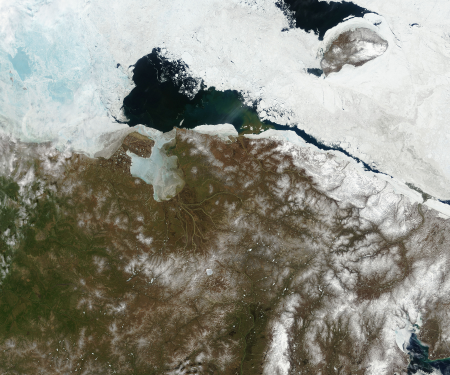Methane Trigger for Geo & Bio Engineering
Methane (CH4) is 20-25 times more powerful a greenhouse gas than carbon dioxide (CO2). We're quite familiar with one source of atmospheric methane -- enteric fermentation in cattle (see my innumerable posts about cheeseburger carbon footprints). But there's another source of methane that has the potential to be far greater in volume, and correspondingly far more threatening to the climate. It's the methane from bogs and marshlands that is trapped under the Siberian permafrost.
Well, that was trapped. As the permafrost melts, the methane is now starting to leak out.
Methane, a potent greenhouse gas, is leaking from the permafrost under the Siberian seabed, a researcher on an international expedition in the region told Swedish daily Dagens Nyheter on Saturday."The permafrost now has small holes. We have found elevated levels of methane above the water surface and even more in the water just below. It is obvious that the source is the seabed," Oerjan Gustafsson, the Swedish leader of the International Siberian Shelf Study, told the newspaper.
The tests were carried out in the Laptev and east Siberian seas and used much more precise measuring equipment than previous studies, he said.
And that's pretty much all that's been said, so far. It does seem to confirm Russian reports from a couple of years ago. But it's unfortunate that the reporters covering this didn't mention just how much methane is trapped under the permafrost in Siberia, because the amount is staggering.
The most conservative estimates I've seen start at around 70 billion metric tons of methane -- the equivalent in greenhouse terms to 1.6 trillion metric tons of CO2. As a point of comparison, the total annual greenhouse footprint in the US is about 7 billion tons; globally, the annual footprint is about 30 billion tons.
If this methane leak continues to increase, we may be facing a disastrous result that no amount of renewable energy, vegetarianism, and bicycling will help. This is one scenario in which the deployment of geoengineering is over-determined, probably needing to remain in place for quite a while as we try to remove the methane (or, at worst, wait for it to cycle out naturally over the course of a decade or so). It's also a scenario that might require large-scale use of bioengineering. As I wrote a few years ago, when the Russian reports started to come out:
Chemical processes in the atmosphere break down CH4 (in combination with oxygen) into CO2+H2O -- carbon dioxide and water. In addition, certain bacteria -- known as methanotrophs -- actually consume methane, with the same chemical results. [...] It appears to me that what will be the most effective means of mitigating and remediating the gargantuan methane excursion from the Siberian permafrost melt would be using genetically-modified forms of methanotrophic bacteria, with greater oxidation capacity and the Archaea-derived resistance to extreme cold (these may well go hand-in-hand, as one way that deep sea methanotrophs survive the icy depths is through internal energy production from methane consumption). Given the size of the region, we'll need lots of them, but that's another advantage of biology over straight chemistry: the methanotrophs would be reproducing themselves.
Is it a perfect solution? No -- it's unproven, with unknown implications, and (at the very least) would result in some levels of CO2 emissions (although with a far smaller greenhouse footprint than the original methane). But the leak of permafrost methane is one of those lesser-known stories that could end up determining whether we make it through this century or not. It's one of the reasons why I think that geoengineering is a near-certainty.
Such fun.







Comments
I entirely concur. Also I forgot to say - I watched your presentation a few weeks ago, and really enjoyed it. I thought the prefabricator stuff was possibly tied in a little too loosely, but for the most part you hit all the buttons that I use when arguing along similar lines, only far more professionally!
Posted by: Daniel Johnston | August 30, 2008 3:32 PM
For the last couple of years, I've been writing a little bit about the methane cycle because it seems to me that managing methane - even if the not-so-permafrost doesn't release another atom - gives us more leverage than concentrating exclusively on CO2.
Another methane wild card is clathrates. When do they start releasing their methane to the atmosphere? Evidently, it has happened before.
And we live in a world where the Republicans can gain public approval by trumpeting the idea that drilling for oil offshore will be the solution to gasoline prices today.
Posted by: gmoke | August 30, 2008 7:53 PM
It's so odd because I distinctly remember reading about this in the 1980s in the book "the next hundred years", so this isn't exactly news.
Posted by: khannea | August 31, 2008 11:48 AM
There was a recent and good BBC TV documentary short series called "The Power of the Planet". In one of them the presenter went to the Siberian permafrost, explains the problem, pokes holes in the ice, and sets fire to it, yes ice burning, in some the flame was several feet high. See the online clip here http://www.bbc.co.uk/mediaselector/check/sn/tvradio/programmes/earthpoweroftheplanet/video/epopatmos02?size=16x9&bgc=000000&nbram=1&bbram=1&nbwm=1&bbwm=1
Posted by: John B Stone | August 31, 2008 5:00 PM